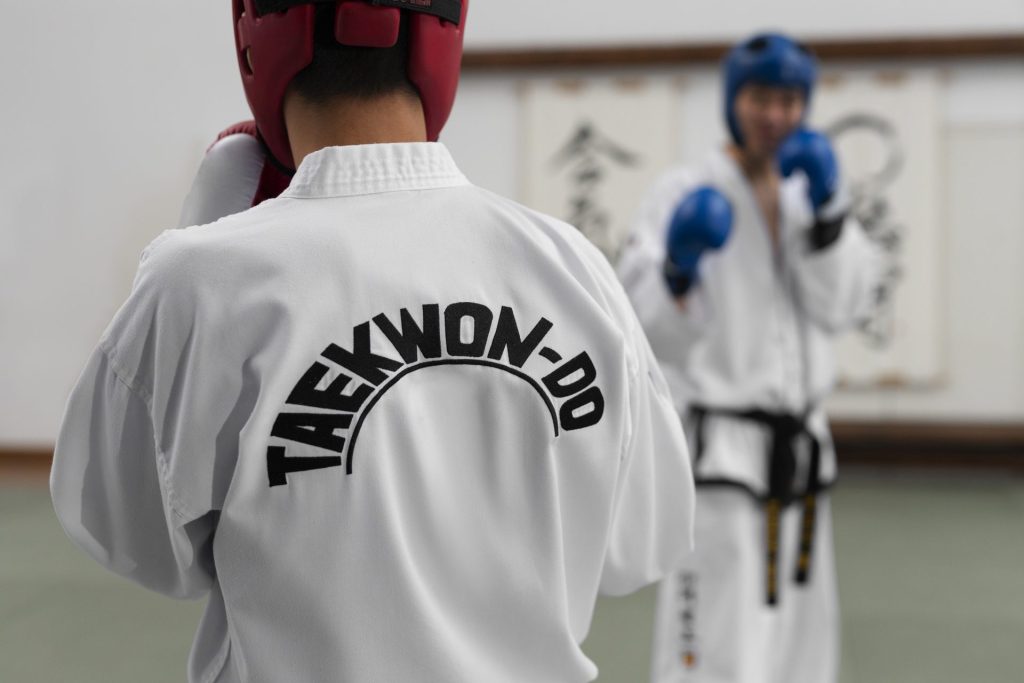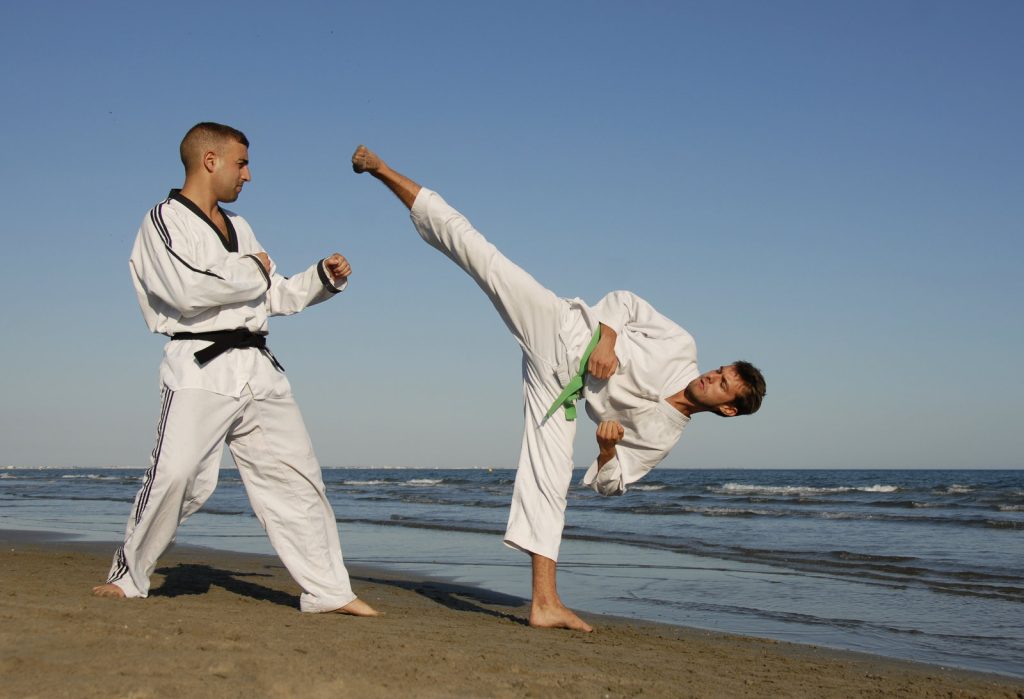Have you ever seen someone wearing a colorful belt and wondered what it meant? In Taekwondo, belt colors signify rank and experience, and they aren’t just for show.
Taekwondo is a Korean martial art that emphasizes discipline, focus, and physical fitness.
Belt progression is an essential part of the art and motivates practitioners to strive for higher levels of skill and knowledge.
As in any sport, the progression from beginner to expert is essential in Taekwondo. The art is divided into several belt levels, with each stage representing a student’s competence and expertise.
Climbing through the ranks isn’t an easy feat, but it’s a journey worth taking for those who aspire to be true martial artists. This article will provide an overview of Taekwondo belt levels and what it takes to progress through them.
Contents
Origins Of Taekwondo
Taekwondo as a martial art originated in Korea and has its roots in various traditional Korean martial arts, such as Taekkyeon and Subak. These martial arts were practiced for self-defense and military training purposes.
During the Japanese occupation of Korea (1910-1945), Japanese martial arts, particularly Karate, had a significant influence on the development of Korean martial arts. Many Korean martial artists trained in Japan and brought back their knowledge and skills to Korea.
Taekwondo Belt Ranking System Explained
In Taekwondo, the three main governing bodies are the World Taekwondo Federation (WT), American Taekwondo Association, and the International Taekwon-Do Federation (ITF). Each organization has its own belt ranking system, which outlines the progression of a practitioner’s skill level and knowledge. Here’s an explanation of both systems:
- The Junior group, comprising of color belts known as “Geups,” consists of approximately 10 (ITF) to 12 (WT) individuals at each rank. The progression through these ranks involves advancing from one Geup to the next. Beginners always commence their journey by wearing a white belt and then proceed to complete eight additional Geup levels before ultimately attaining the esteemed black belt rank.
- The senior group in martial arts is composed of nine distinct black belt ranks, each of which is referred to as a “dan.” The term “dan” is a Korean word meaning “degree.” To attain a “dan” rank, a student must first complete all of the ranks within the junior group.
WT Belt Ranking System:
| RANK | BELT COLOR | LEVEL |
| 10th Geup | White Belt | Beginner, no requirements |
| 9th Geup | White belt with yellow stripe | 4th Kup, basic techniques |
| 8th Geup | Yellow belt | 3rd Kup, first pattern |
| 7th Geup | Yellow belt with green stripe | 2nd Kup, basic one-step sparring |
| 6th Geup | Green belt | 1st Kup, advanced one-step sparring |
| 5th Geup | Green belt with blue stripe | 1st Dan, advanced patterns |
| 4th Geup | Blue belt | 2nd Dan, mastery of sparring techniques |
| 3rd Geup | Blue belt with red stripe | 3rd Dan, distinguished performance in tournaments |
| 2nd Geup | Red belt | 4th Dan, contributions to the art of Taekwondo |
| 1st Geup | Red belt with black stripe | 5th Dan, exceptional service to Taekwondo |
| 1st Dan | Black belt | Mastery of all techniques, commitment to Taekwondo |
ITF Belt Ranking System:
| RANK | BELT COLOR | LEVEL |
| 10th Geup | White Belt | Beginner, no requirements |
| 9th Geup | White belt with yellow stripe | Beginner, fundamental techniques |
| 8th Geup | Yellow belt | Beginner, Chon-Ji pattern, footwork |
| 7th Geup | Yellow belt with green stripe | Beginner, Do-San pattern, hand techniques |
| 6th Geup | Green belt | Intermediate, Won-Hyo pattern, sparring |
| 5th Geup | Green belt with blue stripe | Intermediate, Yul-Gok pattern, self-defense |
| 4th Geup | Blue belt | Intermediate, Joong-Gun pattern, board breaking |
| 3rd Geup | Blue belt with red stripe | Advanced, Toi-Gye pattern, advanced techniques |
| 2nd Geup | Red belt | Advanced, Hwa-Rang pattern, weapons |
| 1st Geup | Red belt with black stripe | Advanced, Bo-Staff, special techniques |
| 1st Dan | Black belt | Beginner Black belt, Mastery of all techniques, teaching ability |
ATA (American Taekwondo Association) Ranking System:
| RANK | BELT COLOR | LEVEL |
| White | White | Beginners, no requirements |
| Orange | Orange | Basic techniques, discipline |
| Yellow | Yellow | Self-defence, perseverance |
| Camouflage | Camouflage | Basics of sparring, humility |
| Green | Green | Form and technique, integrity |
| Purple | Purple | Weapons and jump kicks, courage |
| Blue | Blue | Advanced sparring and self-defence, control |
| Brown | Brown | Leadership, teaching ability |
| Red | Red | Performance and tournament training, dedication |
| Black | Black | Mastery of all techniques, commitment to Taekwondo |
Taekwondo Belt Levels In Order
White Belt: Beginning the Journey
The white belt represents the beginning of the Taekwondo journey. At this level, practitioners are introduced to the fundamental techniques and training methods of Taekwondo. They learn basic stances, punches, kicks, and blocks while developing a strong foundation for their future growth. The primary goal for white belt practitioners is to grasp these fundamental techniques and understand the essence of Taekwondo.
To progress from white belt to the next level, it is important to stay dedicated and committed to training. Regular practice, attending classes, and seeking guidance from instructors are essential for honing skills and acquiring the knowledge required for advancement.
Yellow Belt: The Path Takes Shape
The yellow belt marks the transition from beginner to intermediate level. At this stage, practitioners start to gain confidence in their abilities and explore more advanced techniques and forms. They learn patterns (forms or poomsae) that involve intricate movements, improving their coordination and focus.
Building discipline and focus becomes crucial during the yellow belt phase. Practitioners are encouraged to maintain consistency in training and develop mental fortitude to overcome challenges. Setting specific goals and working towards achieving them can help yellow belt practitioners stay motivated and progress further.
Green Belt: Growing in Skill and Knowledge
The green belt signifies growth and advancement in both skill and knowledge. At this level, practitioners expand their repertoire of techniques and further refine their execution. They delve into more complex forms, emphasizing fluidity, accuracy, and power.
In addition to forms, green belt practitioners engage in increased sparring and self-defense training. They learn to apply their techniques effectively in practical situations, further developing their combat skills. Mental and physical endurance are key areas of focus during the green belt phase, as practitioners push their limits and strive for improvement.
Blue Belt: Progressing Towards Mastery
The blue belt represents progress towards mastery in Taekwondo. Practitioners at this level delve deeper into advanced techniques and combinations. They enhance their speed, power, and precision, aiming to execute techniques flawlessly and with maximum impact.
As blue belt practitioners gain more confidence in their abilities, they may set goals to participate in local or regional competitions. Competition provides a platform to test skills, gain experience, and challenge oneself. It also fosters sportsmanship, resilience, and personal growth.
Red Belt: Approaching Expertise
The red belt signifies the practitioner’s approach to expertise in Taekwondo. At this level, practitioners demonstrate mastery of complex forms and techniques. They continue to refine their sparring skills, engaging in high-intensity training and honing their strategies.
Red belt practitioners focus on preparing for the ultimate challenge: the black belt test. They work diligently to strengthen their physical and mental capabilities, pushing boundaries and surpassing their own limitations. The red belt phase is a transformative period that demands dedication, perseverance, and a deep understanding of Taekwondo principles.
Black Belt: The Ultimate Achievement
The black belt is the ultimate achievement in Taekwondo and represents the pinnacle of mastery. Black belt practitioners embody the principles of Taekwondo both inside and outside the dojang (training hall). They are expected to demonstrate exceptional skill, discipline, and leadership.
Black belt practitioners have a profound understanding of Taekwondo’s philosophies and uphold its values. They serve as role models for other practitioners, inspiring and guiding them on their own journeys. Furthermore, black belt holders are expected to contribute to the Taekwondo community by sharing their knowledge and experiences, teaching and mentoring others, and promoting the art.
How Long Does It Take to Get a Black Belt in Taekwondo?
The answer to the question of how long it takes to earn a black belt in Taekwondo is that it depends on several factors. Age, dedication, training frequency, available resources, and natural abilities all affect the timeline. Typically, it takes anywhere between three to five years of consistent work and training to earn a black belt in Taekwondo.
But this is just an estimated timeline, and the actual time frame can vary due to many reasons. Younger students generally take less time to achieve the goal as they are often able to adapt quickly to the new techniques. Whereas older students may take longer due to injuries or simple wear and tear over time.
The most crucial determinant in getting a black belt in Taekwondo is the amount of time, hard work, and dedication put in by the individual practitioner.
In Taekwondo, it is essential to practice regularly and consistently, with a good instructor to guide you on your path to self-improvement.
Remember, martial arts are not just about techniques or belt rankings, but rather, it’s about the journey and mastery of oneself.
One common misconception about the time required to get a black belt in Taekwondo is the notion that a certain prescribed number of training hours or classes are mandatory for promotion. It’s important to realize that each student is different, and some may require more training time compared to others to achieve the same skillset. In short, it’s not about the number of hours being clocked, but the quality of the training put in.
Conclusion
Climbing the ranks in Taekwondo through the belt levels is a transformative experience. Each belt level represents a different stage in a practitioner’s journey, offering new challenges and opportunities for growth.
From the white belt’s humble beginnings to the black belt’s mastery, Taekwondo cultivates discipline, perseverance, focus, and self-confidence.
To all Taekwondo practitioners, whether just starting out or on the path to achieving the black belt, embrace the challenges, celebrate the accomplishments, and never lose sight of the core principles that Taekwondo embodies.
Remember that the journey itself is the true reward, and the growth you experience along the way is invaluable. As you climb the ranks in Taekwondo, may you find strength, resilience, and fulfillment in your pursuit of excellence.



